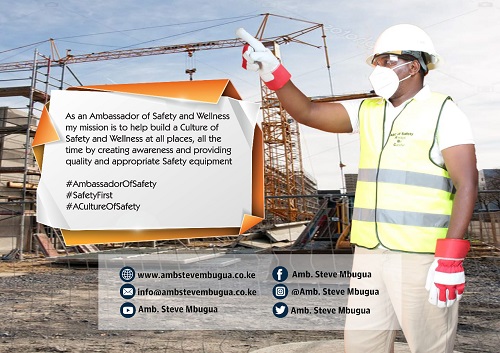Forest safety is essential for protecting both the environment and the individuals who work and explore within these vast natural landscapes. As Ambassador Steve Mbugua, the globally recognized Ambassador of Safety, I am committed to promoting best practices in forest safety to ensure the well-being of workers, adventurers, and the ecosystems they encounter. In this article, we explore key strategies for enhancing forest safety, including fire prevention, safe logging practices, wildlife awareness, and emergency preparedness. By prioritizing forest safety, we can protect lives, preserve biodiversity, and maintain the health of these vital ecosystems. Let’s delve into the essential components of effective forest safety management and work together to safeguard our forests for future generations.
Forest safety encompasses strategies and practices aimed at protecting individuals, wildlife, and the environment in forested areas. It involves proactive measures to prevent accidents, mitigate risks, and respond effectively to emergencies. Here’s a detailed guide to forest safety:
Introduction to Forest Safety
Forest safety focuses on the protection of human life, property, and natural resources within forested environments. It includes activities such as hiking, camping, logging, and recreational use. Safety measures are essential to minimize the risk of accidents, injuries, and environmental damage.
Common Hazards in Forest Environments
1. Wildlife Encounters: Risks associated with encountering wild animals such as bears, snakes, and insects.
2. Weather Extremes: Exposure to extreme weather conditions like heatwaves, thunderstorms, and blizzards.
3. Terrain Challenges: Hazards related to rugged terrain, steep slopes, and unstable ground.
4. Fallen Trees and Branches: Potential injuries from falling trees or branches, especially during storms.
5. Fire Hazards: Risks of wildfires due to dry conditions, lightning strikes, or human activities.
6. Water Hazards: Dangers posed by rivers, lakes, and streams, including drowning and hypothermia.
7. Navigational Issues: Getting lost or disoriented in dense forests or unfamiliar trails.
8. Plant Poisoning: Contact with toxic plants like poison ivy or ingestion of poisonous berries.
9. Equipment Malfunctions: Failures of camping gear, navigation tools, or climbing equipment.
10. Human Threats: Potential encounters with other forest users or illegal activities like poaching.
Latest Trends in Forest Safety
1. Technology Integration: Use of GPS devices, mobile apps, and satellite imagery for navigation and emergency communication.
2. Wildlife Monitoring: Adoption of wildlife tracking systems to alert visitors about nearby animal activity.
3. Fire Prevention: Implementation of controlled burns, firebreaks, and early detection systems to prevent wildfires.
4. Community Engagement: Involvement of local communities in forest management and safety education.
5. Environmental Conservation: Integration of sustainable practices to preserve forest ecosystems while ensuring visitor safety.
6. Remote Medical Support: Telemedicine services and remote first aid training for emergencies in isolated areas.
7. Climate Adaptation: Strategies to address climate change impacts on forest safety, such as increased fire risk and extreme weather events.
8. Visitor Education: Programs to educate visitors about forest hazards, Leave No Trace principles, and responsible outdoor behavior.
9. Emergency Response Planning: Collaboration with local authorities and emergency services to improve response times and effectiveness.
10. Risk Assessments: Regular assessments of trail conditions, hazard zones, and visitor safety trends.
Forest Safety Audits and Inspections
1. Trail Assessments: Evaluations of trail conditions, signage, and accessibility for all users.
2. Campground Inspections: Checks on facilities, fire pits, and sanitation to ensure safe camping experiences.
3. Fire Safety Audits: Assessments of fire risk zones, emergency exits, and availability of firefighting equipment.
4. Wildlife Management: Monitoring of wildlife populations and implementation of measures to prevent conflicts with visitors.
5. Visitor Behavior Analysis: Observation of visitor behavior to identify risky activities and implement targeted safety measures.
Forest Safety Training and Education
1. Wilderness First Aid: Training in first aid techniques specific to wilderness environments, including trauma care and evacuation procedures.
2. Survival Skills: Instruction on basic survival techniques such as shelter building, fire making, and water purification.
3. Navigation Skills: Courses in map reading, compass use, and GPS navigation for safe travel in remote areas.
4. Fire Safety Training: Education on fire prevention, suppression techniques, and evacuation protocols.
5. Wildlife Awareness: Workshops on identifying and responding to wildlife encounters, including bear safety and snakebite first aid.
6. Environmental Stewardship: Programs promoting responsible outdoor ethics, conservation practices, and Leave No Trace principles.
Installation of Forest Safety Measures
1. Signage and Markings: Clear signage indicating trail routes, hazards, emergency contacts, and rules for visitors.
2. Emergency Communication Systems: Installation of emergency call boxes, satellite phones, or radio communication in remote areas.
3. Weather Monitoring Stations: Placement of weather monitoring devices to track temperature, humidity, and severe weather conditions.
4. Fire Prevention Equipment: Provision of fire extinguishers, fire shelters, and tools for fire management in fire-prone areas.
5. Campsite Facilities: Construction and maintenance of safe campsites with designated cooking areas, waste disposal, and water sources.
6. Trail Maintenance: Regular clearing of debris, fallen trees, and overgrown vegetation to ensure safe passage for hikers and bikers.
Compliance with Laws and Regulations
1. National Forest Regulations: Adherence to federal regulations governing public lands, including camping permits, fire restrictions, and wildlife protection laws.
2. Local Ordinances: Compliance with municipal laws on noise, waste disposal, and off-road vehicle use in forested areas.
3. Environmental Permits: Obtaining permits for activities such as logging, hunting, or gathering wild plants in protected forest zones.
4. Wildfire Management Plans: Development and implementation of plans to prevent and respond to wildfires, in accordance with state and federal guidelines.
Forest safety is crucial for preserving natural resources and ensuring the well-being of visitors and wildlife alike. By integrating advanced technology, comprehensive training, proactive management practices, and community involvement, forest managers can create safer and more sustainable environments for recreational activities and conservation efforts. Continuous evaluation, education, and adaptation to emerging challenges are essential for maintaining effective forest safety programs that meet the needs of diverse stakeholders and protect valuable natural landscapes.
In conclusion, forest safety is a critical aspect of environmental stewardship and human safety, requiring proactive measures and continuous vigilance. As the Ambassador of Safety, I have highlighted the importance of fire prevention, safe operational practices, and heightened awareness of natural hazards. By adopting these strategies, we can minimize risks, protect natural habitats, and ensure the safety of those who work and explore in forested areas. Let us commit to championing forest safety and collaborate to create a future where our forests are preserved and cherished. Embracing these practices not only safeguards lives but also supports the sustainability and resilience of our planet’s precious ecosystems.
READ MORE
Mining Safety
Workplace Safety Video
Environmental Safety
Largest Safety Company



















